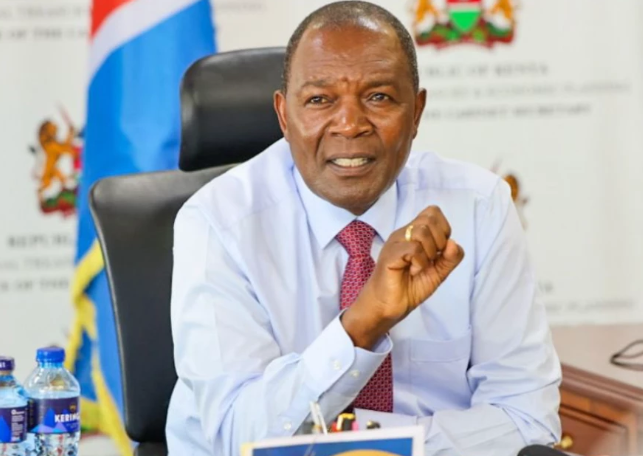Kenya’s budget deficit for the financial year 2024-25 could exceed the planned Sh597 billion, according to experts, potentially leading to increased government borrowing.
This anticipated shortfall is attributed to revenue shortfalls and low productivity in key sectors, compounded by Kenya’s status as a net importer.
The country’s inadequate investment in factors of production—land, labor, capital, and entrepreneurship—is seen as a primary cause of the low productivity.
A budget deficit occurs when government expenditure surpasses tax revenue collected. Even though the National Treasury has outlined a spending plan of Sh3.9 trillion for 2024-25 (up from Sh3.7 trillion), with recurrent expenditures set to rise to Sh2.84 trillion (from Sh2.53 trillion), new employment freezes are in effect.
Cabinet Secretary Njuguna Ndung’u has projected a fiscal deficit, including grants, at Sh597.0 billion, a decrease from Sh925.0 billion in the previous fiscal year.
“The fiscal deficit will be financed by net external borrowing of Sh333.8 billion and net domestic borrowing of Sh263.2 billion,” he said during last week’s budget reading.
However, this is now projected to increase through supplementary budgets.
“We have seen supplementary budgets which are not very emotive being used to sneak in some expenditures, so it might still go up,” said Ken Gichinga, Chief Economist at business analytics consulting firm–Mentoria Consulting.
During a post-budget forum hosted by the American Chamber of Commerce-Kenya yesterday, concerns were raised about the factors contributing to Kenya’s projected rise in budget deficit. A significant driver is expected to be revenue shortfalls, with the Kenya Revenue Authority (KRA) consistently missing its targets.
The National Treasury anticipates total revenue collection, including appropriation-in-aid, to reach Sh3.34 trillion for the financial year 2024-25, up from Sh2.96 trillion in the current fiscal year ending June 30.
KRA has been tasked with a higher target for ordinary revenues at Sh2.92 trillion, compared to Sh2.57 trillion currently. The Parliamentary Budget Office had previously forecasted that KRA might miss its current year target by approximately Sh300 billion.
Looking ahead, KRA faces additional challenges in the next financial year due to public protests against the Finance Bill 2024, prompting the government to concede to demands and eliminate several tax measures.
This adjustment is expected to reduce potential revenue collection by about Sh302 billion. Abraham Rugo, the country manager for International Budget Partnership (now Bajeti Hub), noted that these ambitious revenue targets coincide with a contracted economy, posing further difficulties for tax collection.
“When you look at the projections of moving revenue to Sh3 trillion in the next financial year, when there is already a clear indication that even in the current financial year they are likely to miss the revenue target by almost Sh300 billion, we see it as being too aggressive,” he said.
The Kenyan government has faced pressure from international financial institutions like the IMF and World Bank to increase revenue generation to meet budgetary obligations, particularly for debt repayment, as the country has been at risk of default. Approximately Sh6 out of every Sh10 collected in taxes goes towards servicing debt, which totaled Sh10.4 trillion as of March.
To stimulate economic growth and job creation, there’s been a call to invest more in key sectors such as agriculture and manufacturing.
The Treasury has allocated Sh54.6 billion to the agriculture sector, up from Sh49.9 billion, and proposed Sh23.7 billion under various Ministries, Departments, and Agencies to support local industries.
This includes Sh4.5 billion for County Integrated Agro-Industrial Parks and Sh1.9 billion for Export Processing Zones.
Despite these efforts, challenges persist, including an unpredictable tax regime, which impacts sectoral performance. For instance, the manufacturing sector’s growth slowed to two per cent in 2023, falling short of the government’s target to increase its GDP contribution from 7.2 per cent in 2021 to 20 per cent by 2030, as highlighted in the Economic Survey 2024.
Manufacturers have expressed concerns about the delay in adopting the National Taxation Policy, which aims to provide certainty and consistency in tax policies, including frameworks for tax incentives and a favorable regulatory environment for both local and foreign investors.
“Exporters continue to be faced with export barriers such as delays in VAT refunds, and high costs of intermediate products, and inputs including packaging costs which deter exports in the manufacturing sector,” Kenya Association of Manufacturers CEO Anthony Mwangi said.
High pending bills at both national and county governments, valued at Sh662.3 billion as of November, also continue to stifle businesses.



